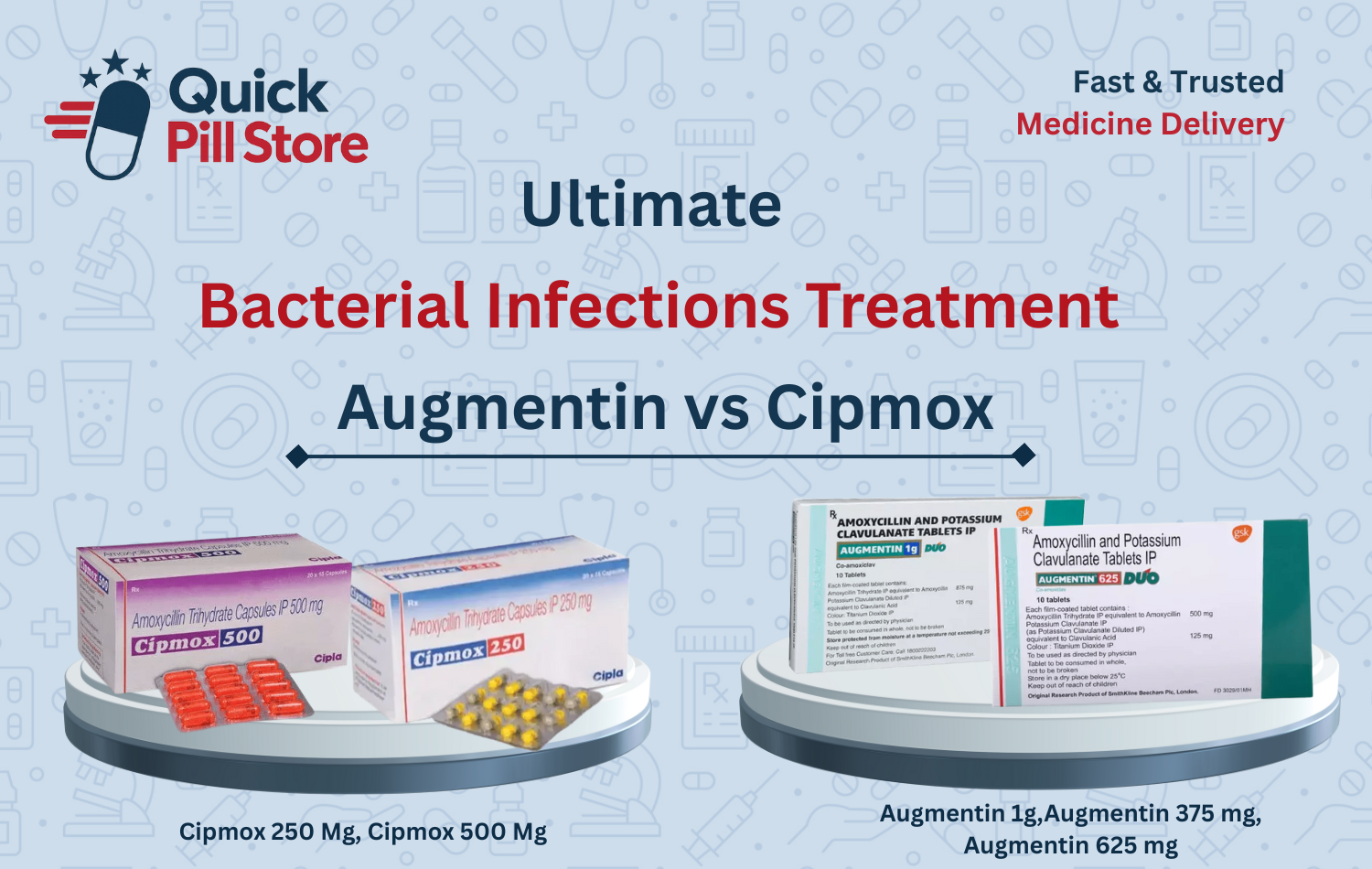Introduction
Bacterial infections affect millions globally, ranging from mild throat infections to severe pneumonia or urinary tract infections. Choosing the right antibiotic is critical for effective bacterial infections treatment. Two widely prescribed antibiotics are Augmentin and Cipmox.
In this guide, we’ll explore key differences between Augmentin and Cipmox, including composition, uses, dosages, effectiveness, side effects, and safety tips, to help you make an informed decision.
What is Augmentin?
it is a broad-spectrum antibiotic that combines amoxicillin and clavulanic acid. Amoxicillin kills bacteria directly, while clavulanic acid prevents bacterial resistance, making Augmentin 1g effective against a wide range of infections. It is commonly used to treat respiratory infections, ear, nose, and throat infections, urinary tract infections, skin infections, and dental infections. Available in tablets, syrups, and injections, Augmentin dosage depends on the patient’s age, weight, and infection severity. Taking the full prescribed course ensures effective bacterial infection treatment and prevents resistance. Always follow a doctor’s guidance.
Key Benefits:
- Effective against resistant bacterial infections
- Treats respiratory, urinary, skin, ear, and dental infections
Focus Keyword Usage: Bacterial Infections Treatment, Augmentin, Bacterial Infections.
What is Cipmox?
Cipmox is an antibiotic containing Amoxicillin, commonly used to treat mild to moderate bacterial infections. As a penicillin-class antibiotic, Cipmox 250 Mg works by stopping bacterial growth, making it effective against infections of the throat, ear, respiratory tract, skin, and urinary system. Unlike Augmentin, Cipmox does not contain clavulanic acid, so it may be less effective against resistant bacterial strains. Available in capsules (250 mg, 500 mg) and oral syrup, Cipmox dosage depends on the patient’s age, weight, and infection severity. Completing the full course ensures proper bacterial infections treatment and prevents resistance.
Common Uses:
- Throat infections (tonsillitis, pharyngitis)
- Ear infections
- Skin and urinary tract infections
Focus Keyword Usage: Cipmox, Bacterial Infections Treatment, Bacterial Infections
Key Differences Between Augmentin and Cipmox
| Feature | Augmentin | Cipmox |
|---|---|---|
| Composition | Amoxicillin + Clavulanic Acid | Amoxicillin |
| Strength | Stronger, fights resistant bacteria | Effective for mild infections |
| Common Uses | Severe respiratory, UTIs, dental infections | Mild to moderate infections |
| Cost | Higher | Affordable |
| Side Effects | Slightly higher | Fewer |
Focus Keyword Placement: Bacterial Infections Treatment, Augmentin, Cipmox 500 Mg
Dosage Comparison
Augmentin Dosage
| Form | Adult Dose | Notes |
|---|---|---|
| 375 mg | 1 tablet every 8 hours | Mild infections |
| 625 mg | 1 tablet every 8–12 hours | Moderate to severe infections |
| 1 g | 1 tablet every 12 hours | Severe infections |
Children: 20–40 mg/kg/day (Amoxicillin component) in 2–3 divided doses
Cipmox Dosage
| Form | Adult Dose | Notes |
|---|---|---|
| 250 mg | 1 capsule every 8 hours | Mild infections |
| 500 mg | 1 capsule every 8 hours | Moderate infections |
Children: 25–50 mg/kg/day divided into 2–3 doses
Proper dosage ensures effective bacterial infections treatment and reduces risk of resistance.
Effectiveness
- Augmentin: Stronger due to Clavulanic Acid; ideal for resistant bacterial infections
- Cipmox: Effective for mild infections; less effective against resistant strains
Doctors decide based on infection severity, age, and medical history.
Side Effects
Augmentin:
- Diarrhea, nausea, vomiting
- Rare: liver enzyme changes, allergic reactions
Cipmox:
- Mild diarrhea, stomach upset
- Rare: allergic reactions, rash
Always consult a doctor if side effects persist.
Cost and Availability
- Augmentin: Higher cost; widely available in tablets and syrup
- Cipmox: Affordable; available in capsules and syrup
Recommended Use
- Augmentin: Severe, resistant, or recurring bacterial infections
- Cipmox: Mild to moderate bacterial infections
Complete the full antibiotic course for effective bacterial infections treatment.
FAQs:
Q1. Can Cipmox replace Augmentin for severe infections?
➡️ No. Cipmox is less effective against resistant bacteria; Augmentin 375 mg is preferred.
Q2. What is the usual adult dose of Augmentin 625 mg?
➡️ 1 tablet every 8–12 hours, depending on infection severity.
Q3. What is the usual adult dose of Cipmox 500 mg?
➡️ 1 capsule every 8 hours for mild to moderate infections.
Q4. Can children take Augmentin or Cipmox?
➡️ Yes, but doses must be calculated based on weight.
Q5. Which antibiotic is cheaper, Augmentin or Cipmox?
➡️ Cipmox is usually more affordable.
Q6. Can Augmentin be taken without food?
➡️ No, take with food to reduce stomach upset.
Q7. Can Cipmox be taken without food?
➡️ Yes, with or without food.
Q8. How long does it take to recover from bacterial infections?
➡️ Mild infections: 5–7 days; severe infections may take longer.
Q9. Is it safe to stop antibiotics once symptoms improve?
➡️ No. Always complete the full course to prevent resistance.
Q10. Are Augmentin and Cipmox safe during pregnancy?
➡️ Only under doctor supervision; both are generally safe when prescribed.
Conclusion
Both Augmentin and Cipmox are effective for bacterial infections treatment.
- Cipmox: Best for mild infections, cost-effective
- Augmentin: Stronger, ideal for resistant or severe infections
Always consult your doctor to select the right antibiotic and complete the full course for optimal results.

